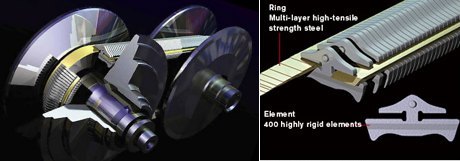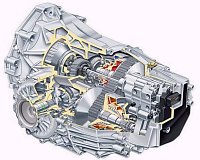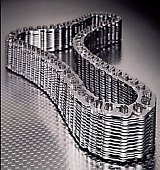| |
AUTOZINE TECHNICAL SCHOOL
Continously Variable Transmission (CVT) Introduction
Continuously Variable Transmission is getting more and more popular on small to mid-size cars, eating the market share of manual and low-end automatic transmissions. In 2015, the world produced 11.3 million CVTs. It is expected to grow to 18.2 million units by 2022. In theory, CVT is an ideal transmission. It varies the transmission ratio continuously so that you can say it is an automatic transmission with infinite number of ratios. As a result, you can always get the optimum ratio to enhance fuel efficiency or performance, depending on needs. There are mainly 3 types of CVT: belt-drive, chain-drive or roller-drive (toroidal). Belt-drive CVT is by far the most popular with a global market share of more than 90 percent. Key manufacturers include Jatco (Nissan), Aisin (Toyota), Honda, ZF and Punch. We start from it first. Belt-drive CVT 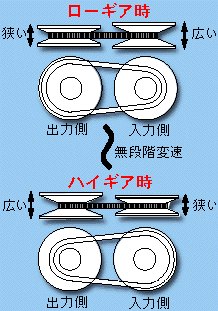 Working Principles Working PrinciplesThe core of belt-drive CVT consists of a driving belt running between two pulleys, one connect to the engine output and one to the propeller shaft. Each pulley comprises of 2 conical discs which form a V-shaped valley between them. The distance between the discs is adjustable by hydraulic. When the discs are positioned far apart, the belt runs in an orbit with small diameter, which equals to a small gear of conventional gearbox. When the discs are pushed close to each other, the belt is pushed outward and runs in an orbit of large diameter, which equals to a large gear. As a result, the transmission ratio can be varied by pressuring or loosening the discs. When one pulley is varied, another pulley must adapt itself inversely since the length of the belt is fixed. This multiply the change of transmission ratio, too. From Rubber to Steel Belt The most critical part of CVT is the steel belt. Since it is highly stressed, it must be very strong and grip very well on the pulleys, yet it should be flexible and generate low friction. Whenever talk about steel belt, Dutch company Van Doorne Transmissie B.V. (VDT) has to be credited. Its founder Hub Van Doorne was the pioneer of CVT as well as the founder of Dutch car maker DAF. He developed the first mass production CVT for the use of DAF and Volvo small cars from 1958. However, the rubber belt it used was not strong or durable enough. VDT changed to an innovative steel belt and spent many more years to refine the design. In 1987, the steel-belt CVT finally reached mass production, debuting on Subaru Justy, Fiat Uno 60 Selecta and Ford Fiesta. All these cars had engines smaller than 1300 c.c. because the belts were not strong enough for higher torque. As belt construction and materials improved further over the years, it was applicable to 2-liter class by the late 1990s, and then 3.5-liter class from 2002.
Further Development Although Fiat and Ford involved CVT development early, it was the Japanese who made CVT popular. Subaru has been using CVTs on its mini cars since Justy and expanded to all its model lines in recent years. Nissan and Honda joined the trend in 1992 and 1995 respectively, whereas Toyota/Aisin entered in 2000. Why are the Japanese so keen? Because most Japanese cars used to be sold with automatic, and CVT is a cheaper alternative. Among them, Nissan uses CVT the most extensively - the majority of its cars sold in Japan and North America are equipped with CVT. It initially got the technology from Subaru, then started developing its own. From 1997, its second generation CVT called Hyper-CVT was already capable to handle 2-liter class engines. Next year, the M6 Hyper-CVT on Primara even added Tiptronic-style manual override, simulating a 6-speed manual to enhance driver engagement. Nissan CVTs used torque converter instead of clutch to enable smoother standing start acceleration. In 1999, Nissan spun off its transmission division to become Jatco, which is now the world's No. 1 CVT producer. It supplies also other car makers, such as Suzuki, Chrysler and GM. In 2002, Nissan/Jatco launched its third generation CVT, Xtronic. It had the gear ratio spread widened to 6.0 to enhance efficiency. More important, the ratio mapping was revised to give a more linear acceleration in order to relieve the so-called "rubber band effect". Rubber band effect is indeed the biggest annoyance of CVTs. It is caused by the mismatch between engine rev/noise and vehicle speed during acceleration. In a car with manual or automatic gearbox, the gear ratio is fixed, so the engine rev/noise rises proportionally to vehicle speed until upshift, and we perceive this as a natural driving experience. In contrast, CVT keeps the engine revving near the power peak during hard acceleration. It does this by lowering the transmission ratio continuously while the car is accelerating. As a result, the engine revs and screams hard, but the vehicle speed fails to catch up initially. It feels like the clutch is slipping or replaced with an elastic rubber band. As the ratio approaches the lowest end, the vehicle speed finally catches up, but the initial delay has already hampered the driving pleasure. 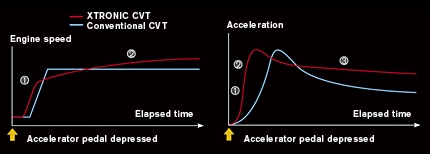 The Xtronic CVT relieved rubber band
effect by using a
different ratio curve. It did not lock the engine rev constant, but
allowed it to keep rising gently following the initial surge. The
result was a more linear driving characteristic, if not as linear as
conventional transmissions with fixed ratios. Inevitably, this
sacrificed efficiency a little. It goes without saying you cannot have
your cake and eat it. The Xtronic CVT relieved rubber band
effect by using a
different ratio curve. It did not lock the engine rev constant, but
allowed it to keep rising gently following the initial surge. The
result was a more linear driving characteristic, if not as linear as
conventional transmissions with fixed ratios. Inevitably, this
sacrificed efficiency a little. It goes without saying you cannot have
your cake and eat it.I believe Xtronic was the first belt-drive CVT to adopt this transmission characteristic. However, 3 years before it, Audi already put the idea into production with its chain-drive Multitronic CVT. In 2009, the second generation Xtronic expanded ratio spread further to 7.3 for 2-liter class or 7.0 for 3.5-liter class, matching the state of the art automatics of the time. This is achieved by adding a 2-speed planetary gear auxiliary transmission, whose low gear served up to 20km/h and thereafter switched to the high gear for the rest of the time. Without the planetary gear auxiliary transmission, the pulleys would have to be enlarged to enable the wider ratio spread. 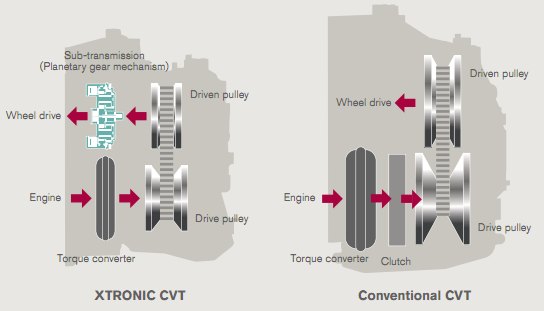 Pros and Cons Theoretically, CVT should be the perfect transmission as it offers the optimum transmission ratio all the time. This means, if you need performance, it should be able to accelerate quicker. If you need economy, it should return better fuel efficiency. However, in reality it usually performed in the opposite way. I have been observing road test data from magazines over the past 30 years and found CVTs have caught up manual transmissions only recently. While CVT is good at keeping the engine running at its most efficient revs, it generates more frictional loss between the belt and pulleys. This takes more lubrication, so the oil pump and oil splash add further losses. According to an earlier research, a typical manual gearbox has a transmission efficiency of 97 percent, whereas belt-drive CVT managed only 88 percent. While the latest CVTs might be better, they still cannot match the low mechanical losses of manual gearboxes. This is why for decades CVT had been known as an unrealized promise. Nevertheless, as the latest generation CVTs have wider ratio spread, they finally manage to beat manual for fuel economy, although the advantage is pretty slim. For example, a 2017 Honda Civic 1.5T CVT returns 56.4 mpg on European cycle, 1.1 mpg more than its manual sister. However, the same cannot be said to performance. As of the time of writing, CVT cars still quote slower 0-60 mph acceleration than their manual versions. The capability of optimum ratio fails to offset the slow motion of its belt adjustment, which takes more time than a conventional gearshift. This slowness means CVTs are not renowned for performance or driving excitement. It makes the manual mode on some CVTs superfluous, because you can get much faster gearshifts from automatic transmissions these days. The rubber band effect does not promote driving excitement either. Although modern CVTs have the effect reduced, the perception of slipping clutch is not going to disappear completely - unless the ratio is locked during acceleration. If you always use manual mode, why do you buy a CVT? Another limitation of belt-drive CVT is torque capacity. Even the stongest version of Nissan/Jatco CVT is capable to withstand only 380 Nm (280 lbft), which makes it hard to be applied to turbocharged six-cylinder motors or high-power turbo diesels. On the plus side, the belt-drive CVT is cheaper to build and more compact than automatic transmission. Therefore it is widely used on affordable cars. Chain-drive CVTs are not very popular on the market, as only Audi and Subaru use them. Both of them employ the key technologies (chain, pulleys, hydraulic control and torque sensor) from German supplier LuK, which did a lot of research in this area. Audi was the first to put it in producton in 1999 on the A6 3.0 V6. Its Multitronic CVT served many front-wheel-drive Audis with engines producing up to 400 Nm (295 lbft), which is the upper limit of the transmission. That was easily more than the contemporary belt-drive CVTs. Subaru introduced the Lineartronic CVT on the 2009 Legacy and then expanded to Impreza etc. Again its usage is limited to 400 Nm.
In general, chain-drive CVT is stronger yet more efficient than belt-type. Take the Audi A6 as an example, it was available with 5-speed manual, 5-speed Tiptronic and Multitronic, so we can easily compare their performance and fuel consumption:
As seen, the Multitronic achieved better performance and fuel economy than others, something unprecedented for a CVT ! Apart from using chain instead of belt, another breakthrough was the use of torque sensor. It ensured the pulleys to clamp the chain with just the right amount of pressure, not more than necessary. In contrast, conventional CVTs always apply excessive pressure to the pulleys in order to cover all possible conditions of use. Excessive pressure results in more fuel consumption and wear. Another factor contributing to improved fuel economy was the use of a wider, 6.05 gear ratio range. That was superior to the 5.0 range of conventional 5-speed manuals and belt-drive CVTs at the time. Besides, by using a multi-plate clutch instead of torque converter or electrohydraulic clutch, the Multitronic cut both energy losses and response delay. Its control system was quite clever. Firstly, it monitored the engine rev and vehicle speed to determine the transmission ratio, making sure the vehicle speed increased together with engine rev. This avoided the "rubber band effect" commonly found on conventional CVTs. Secondly, from the pedal action it could recognize if the driver intended to drive in a performance-oriented or economy-oriented manner, and chose the right ratio accordingly. Lastly, it offered a sequential manual mode with 6 artificial ratios to please the drivers who wanted to be engaged. The mode allowed engine braking and offered an optional steering wheel control for upshift and downshift. In short, the Multitronic CVT was well ahead of its time. Nevertheless, Audi eventually gave up the Multitronic in 2014 in favour of Tiptronic (ZF 8-speed auto) and S tronic (7-speed twin-clutch). The Multitronic was not uncompetitive, but it was not compatible with Audi's Quattro system and more powerful engines, so it cost the company a lot of money to develop each model line for 2 different self-shifting transmissions. Switching to Tiptronic or S tronic altogether would make the development cheaper and production easier. The same problem did not happen on Subaru, which designed its Lineartronic CVT for 4WD from the outset, and the firm does not have any engines producing more than 400 Nm. While chain-drive CVT is an evolution of conventional belt-drive CVT, roller-drive CVT is a revolution, because its working principles are completely different. Roller-drive CVT is so-called because it uses two pairs of rollers instead of belt or chain as the media to vary the transmission ratio. It is also called Toroidal CVT as the rollers are sandwiched between toroidal-shaped input and output discs. Compared with belt or chain-drive CVTs, it is capable to handle higher torque thus is preferred for larger engines. Nissan introduced the world's first and only roller-drive CVT in 1999. Called Extroid CVT, it was first applied to the Nissan Gloria / Cedric, and then Skyline 350GT-8 in 2002. It was developed jointly with NSK, a Japanese bearing specialist. 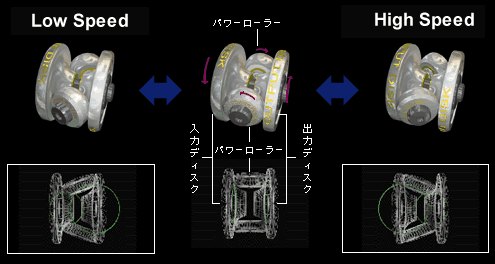 As shown in the picture, the rollers link between the input disc (which is connected to the torque converter/engine) and output disc (which is connected to the prop-shaft), transmitting drive from the former to the latter. Since the rollers can be tilted, transmission ratio can be varied by adjusting the tilt angle. For example, when the rollers meet the input disc near its inner radius and meet the output disc near its outer radius, a high gear ratio is obtained. 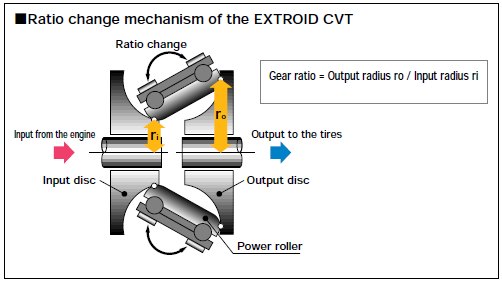 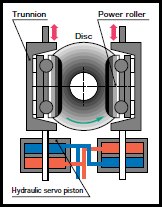 The mechanism adjusting the tilt angle of rollers is pictured at the right hand side above. Each roller is mounted on a trunnion through bearing (that's why NSK was interested in developing this transmission). The trunnion is free to pivot on its own axis, and could be moved upward or downward by hydraulic control.  Let's say if the trunnion is moved upward, the rotational force of the input disc will push the roller outward, thus the roller will be tilted, reducing the gear ratio. Conversely, if the trunnion is moved downward, the roller will be tilted in the opposition direction and increase the gear ratio. Since the discs are rotating at high speed, an upward/downward movement of only 0.1 to 1mm will be sufficient. As a result, the ratio can be changed quickly. 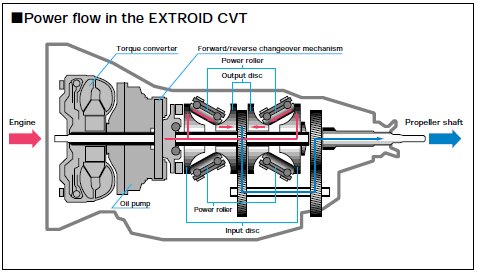 To reduce frictional losses and wear, the
rollers do not make direct contact with the discs, but through a
specially developed viscous oil which provides good traction between
the two surfaces. The oil doubles as lubricant and coolant. To reduce frictional losses and wear, the
rollers do not make direct contact with the discs, but through a
specially developed viscous oil which provides good traction between
the two surfaces. The oil doubles as lubricant and coolant.The Extroid employs 2 sets of rollers and discs so to double its torque capacity to 430 Nm (317 lbft), although Nissan actually used only 286 lbft on the Gloria and Cedric V6 turbo. The 2 sets are positioned in opposite directions such that the output discs join at the middle. Compared with belt or chain, the solid rollers can withstand higher torque. Moreover, since the input and output disc are located at the same axis, it is able to be packaged in a longitudinal gearbox casing and serve rear-wheel-drive cars. On the downside, the Extroid CVT is much longer than belt/chain-drive CVTs. Its ratio spread of 4.33 is no match with Audi Multitronic (6.05), thus limiting fuel efficiency. Moreover, owing to the sophisticated hydraulic control system for rollers (which has to be extremely precise to make sure all rollers tilted at the same angle) and special traction oil, the Extroid was expensive to build. That's why Nissan withdrew it from production in 2006. |
|||||||||||||||||
| Copyright© 1997-2017 by Mark Wan @ AutoZine |
